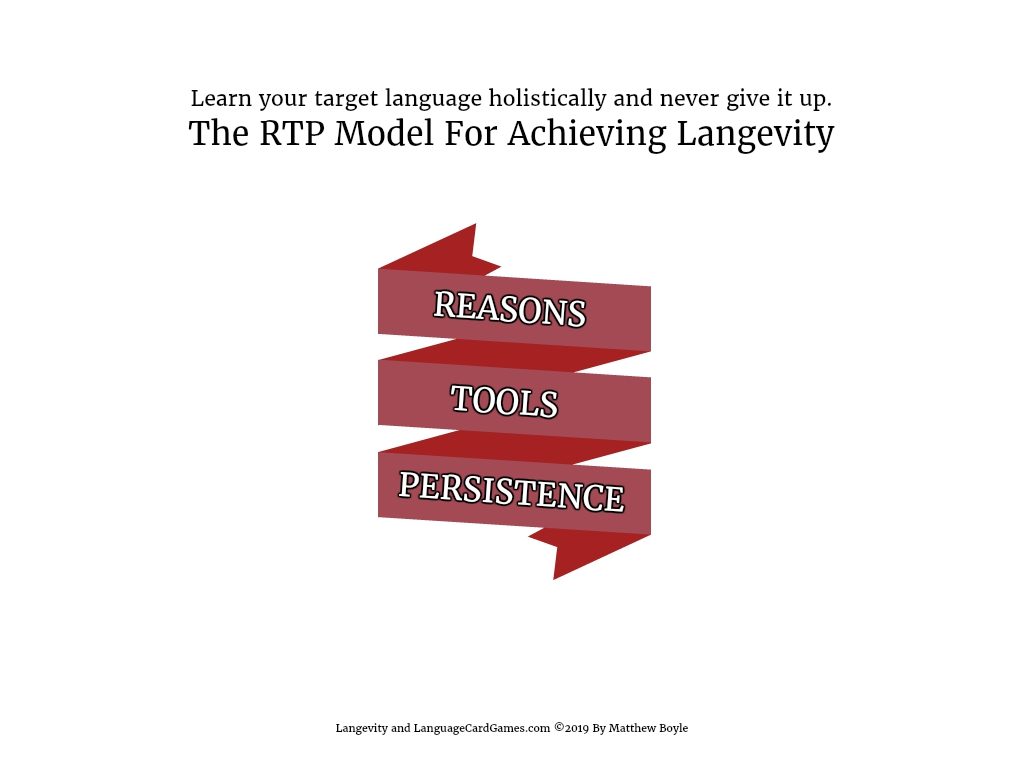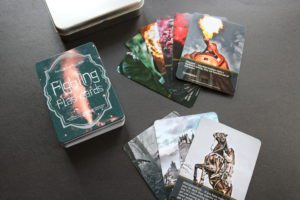
When we decide to undertake our language learning journey – and that’s really what it is, it’s a journey! – we want to learn how to avoid burnout. We want to learn how to work with those plateau periods. We want to figure out how we can keep up and not give up. We want to learn how to build our endurance. We want to learn how to diversify our tactics and our strategies. And we want to find a way to have an enjoyable, holistic experience that ranks high on many metrics of success and that we can sustain across the decades.
If we can accomplish all of these things, it means that we have achieved langevity. Now, at this point, you may be wondering: That all sounds good, but how? Well, I believe that we can practice three essential strategies that are encapsulated in The RTP Model.
In the The RTP Model, the R stands for reasons. The T stands for tools. And the P stands for persistence. And they’re all somewhat related to each other and they all play into each other and we can tweak some to affect the others. But let me break down each of these one-by-one.
The first part of the model, reasons, is really all about examining your motivations, your big why. If your reasons for learning a language are not pure or thoughtful or deep, it could negatively impact your relationship and your results with that language forever after. So here’s the pivot point I want you to consider: don’t study a language to attract fans, do it to attract friends. Don’t study a language to build your resume, do it to build your relationships. Don’t do it to feed your ego, do it to feed your soul.
You know, there’s a brilliant quote attributed to Charlamagne, and I think a lot of you will know it if you’ve been in the language learning arena for long, but I’d like to share it with you anyway. It goes like this: “To have another language is to possess a second soul.” Well, if you haven’t meditated for long on your reasons, you could very well miss out on what he was saying. Get your reasons right, on the other hand, and you will always be able to draw on that inner well of strength and clarity during the tough times.
One simple way that you can work on your intentions and your purposes is always available to you, and that is journaling. Get your motivations and your reasons onto paper where you can start to see them, weigh them, clarify them, and maybe rethink some of your plans and your goals so that you can streamline and dial in your progress moving forward.
The second part of the RTP model stands for tools. And that’s kind of an umbrella term, which includes resources and activities. So learning a new language takes time, there are no halfway measures. And just to drive the point home to you, there’s a Chinese expression that I really like, which means: “There are no shortcuts to any place worth going.”
So inevitably, on this language-learning journey, you will pass through the seasons. Inevitably, you will come face-to-face with boredom, frustration, plateaus, and burnout. And it is especially during those times when you will need activities, and tools, and resources, that are entertaining and inspirational, but also educational, to do. So, yes, I am going to encourage you to find out what kind of books and blogs, poetry and songs, TV shows and movies, apps and games, speak to you! These would be your tools! Don’t listen to anyone who would take the wind out of your sails, telling you that there’s only one right way to learn a language or only one best way to learn a language.
If you’re a follower of my work, you’ll know that card games are something that brought me renewed passion and renewed fire when I was feeling down and out. My great friend, Sanorah, at the Ottawa Language Lounge is doing fantastic things. And this actually something that I want to recommend to you as well if you’ve never tried it before: get a variety of language learners into the same physical space, the same room, get them around a table, get them to unplug in order to reconnect, play a game with them, share your tools with them. You will be surprised at the amount of learning and the depth of learning that comes out during these exchanges and it can really recharge your batteries, too, so that you will be all the more ready to get back out there and study hard. In fact, stay with me until the end of this because I have a special offer for you along these lines.
The third and final part of the model stands for persistence. Persistence. Assuming that you have the right reasons, assuming that you have the right tools, all that’s left that you really need to do is just to persist. And the best way to persist, in my mind, is not always through the plain exertion of effort, although, of course, you will have to do that sometimes. But the best way to persist, I think, is through the proper installation of habits and routines, which then become automatic. So have a routine that is like bulletproof, so the attractions and distractions and excuses of daily life just wither in your presence and lose their power over you.
If you can stick with your language learning habits and routines for just a few weeks, they will become ingrained, and it will become easier to persist than to give up. You will actually feel a bit strange and bad if you don’t carry out your daily language learning habits. And when other people see you they may think: Oh, they must work so hard and I could never do that. And while hard work is certainly part of the equation for you, you’ve also tapped into a trade secret, which is: with better habits comes better persistence.
So I sincerely hope you’ve found this information engaging and efficacious. And I hope you’ll remember the RTP model: reason, tools, persistence. Because if you do, you will not only be able to achieve langevity, but you’ll be able to take advantage of a special offer I have for you. During this month, the month of June, you can apply the coupon code ‘RTP’ when you checkout at LanguageCardGames.com, to take advantage of one of our innovative, language learning products.
Since 2016, we’ve been revolutionizing how people all over the world learn languages, providing them with addicting games, which function kind of like a Trojan horse for language and linguistics learning. We have games for practically any age or ability level and we ship to any location worldwide for free! To learn more about what we have to offer, head directly to LanguageCardGames.com and visit the shop.

